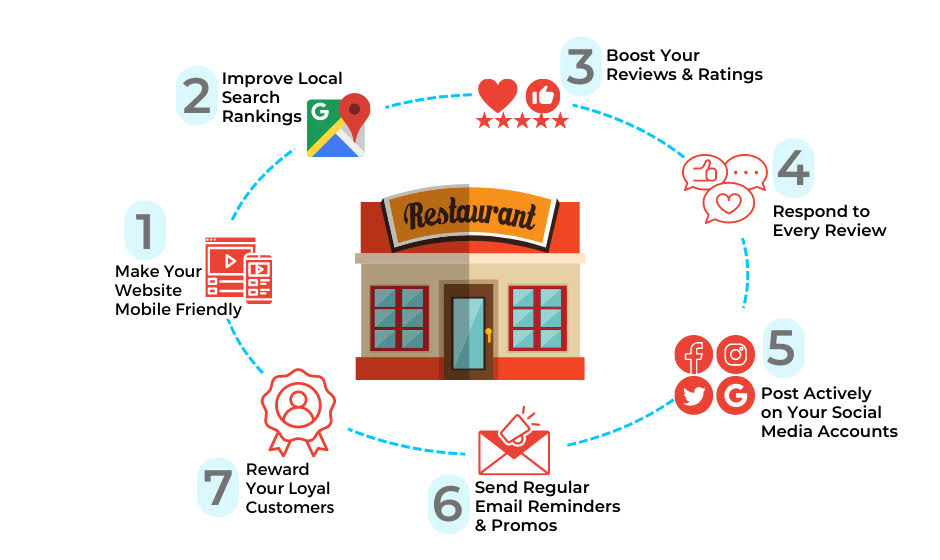Digital Marketing Strategies for Restaurants
In an era dominated by digital interactions, restaurants must adapt their marketing strategies to stay ahead in the competitive culinary landscape. Leveraging the power of digital marketing allows eateries to reach a broader audience. It also enables them to engage with potential customers in meaningful ways. In this blog, we’ll explore effective digital marketing for restaurant strategies tailored for restaurants in Australia. We’ll focus on how to captivate the audience and create lasting impressions.
Social Media Presence
Establishing a strong presence on social media platforms is paramount for restaurants looking to connect with their audience. Platforms like Instagram, Facebook, and Twitter provide an opportunity to showcase the culinary delights, ambiance, and unique offerings of the restaurant. Utilise visually appealing content, including high-quality images and engaging captions, to entice followers and encourage them to share their own experiences. Social media is a powerful tool for running targeted advertising campaigns. Restaurants can leverage paid promotions to reach specific demographics, promote special events, and even offer exclusive deals to their online audience.
Engaging Content Marketing
Content is king in the digital realm, and restaurants can harness its power through content marketing. Create a blog on the restaurant’s website to share stories about the chef, highlight signature dishes, and provide behind-the-scenes glimpses. Regularly updated content not only improves SEO but also keeps the audience engaged and interested in the restaurant’s narrative.Consider incorporating video content, such as cooking tutorials, chef interviews, or virtual tours of the kitchen. Video content is highly shareable and allows the audience to connect with the restaurant on a more personal level.
Email Marketing Campaigns
Building a strong email marketing strategy is an effective way to maintain a direct line of communication with customers. Encourage visitors to subscribe to the restaurant’s newsletter to receive updates on special promotions, new menu items, and upcoming events. Use personalised and visually appealing emails to keep customers informed and engaged. Implementing a loyalty program through email marketing can also incentivise repeat visits. Offer exclusive discounts or freebies to loyal subscribers, creating a sense of appreciation and fostering a lasting connection with the audience.
Optimised Website and Online Ordering
A restaurant’s website serves as the digital storefront, and it should be optimised for a seamless user experience. Ensure the website is mobile-friendly, as many customers use their smartphones to browse menus and make reservations. Include high-quality images of menu items, detailed descriptions, and an easy-to-navigate layout. Additionally, implementing an online ordering system on the website can significantly enhance customer convenience. With the rise of food delivery services, providing an in-house online ordering option allows restaurants to retain a larger share of their profits and offers customers a hassle-free way to enjoy their favorite dishes at home.
Local Search Engine Optimisation (SEO)
Local SEO is crucial for restaurants aiming to attract diners in their vicinity. Optimise the restaurant’s Google My Business profile with accurate information, including business hours, location, and contact details. Encourage satisfied customers to leave positive reviews, as online reviews heavily influence potential diners’ decisions. Implementing local keywords on the website and regularly updating business listings on platforms like Yelp and TripAdvisor can also contribute to improved local search rankings, making it easier for hungry customers to discover the restaurant online.
Influencer Collaborations
Collaborating with influencers in the food and lifestyle niche can provide a significant boost to a restaurant’s digital presence. Identify local influencers with a substantial following and a genuine appreciation for culinary experiences. Invite them for a complimentary meal and encourage them to share their dining experience on their social media channels.The authenticity of influencer recommendations can resonate with their audience, translating into increased visibility and credibility for the restaurant. Consider offering exclusive tasting events or menu previews for influencers to create buzz and anticipation among their followers.
Interactive Contests and Giveaways
Engage the audience by organising interactive contests and giveaways on social media platforms. Encourage users to share their favourite dishes, create unique hashtags, or participate in culinary challenges. Offering enticing prizes, such as free meals or exclusive dining experiences, can motivate participation and generate excitement around the restaurant.
User-generated content from contests and giveaways not only boosts online visibility but also creates a sense of community among followers. This interactive approach fosters a positive relationship between the restaurant and its digital audience.





